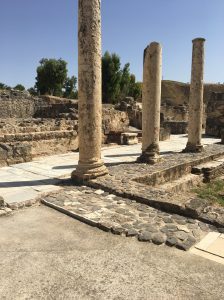 The city of Beit She’an is mentioned in scripture several times. It was a Canaanite site that the people of Israel failed to conquer during Joshua’s invasion (Judges 1:27). In 1 Samuel 31, Saul’s dead body was displayed on the wall of this city following his defeat by the Philistines. The city was burned by King David, but restored to become an administrative city under his son, Solomon (1 Kings 4). We also read where Shishak of Egypt invaded Israel in 924 BC (1 Kings 14:25) and Egyptian hieroglyphic inscriptions tell us that Beit She’an was one of the cities that Shishak captured. The pictures that accompany the hieroglyphics show the governor of Beit She’an being led captive to Egypt. My favorite thing about world history is when the Bible is a proof text for what an ancient manuscript or picture or inscription depicts or vice-versa. And it happens all. the. time.
The city of Beit She’an is mentioned in scripture several times. It was a Canaanite site that the people of Israel failed to conquer during Joshua’s invasion (Judges 1:27). In 1 Samuel 31, Saul’s dead body was displayed on the wall of this city following his defeat by the Philistines. The city was burned by King David, but restored to become an administrative city under his son, Solomon (1 Kings 4). We also read where Shishak of Egypt invaded Israel in 924 BC (1 Kings 14:25) and Egyptian hieroglyphic inscriptions tell us that Beit She’an was one of the cities that Shishak captured. The pictures that accompany the hieroglyphics show the governor of Beit She’an being led captive to Egypt. My favorite thing about world history is when the Bible is a proof text for what an ancient manuscript or picture or inscription depicts or vice-versa. And it happens all. the. time.
I had one more “favorite” thing about Beit She’an and that was the way the history of the city just suddenly came to a halt on that day in 749 A.D. The city lies on a fault line and on that particular day during the Arab rule of the city, a massive earthquake buried the entire city. It lay in ruins until modern times.
As I walked around this amazing city, I saw Roman baths and pieces of beautifully tiled floor murals. You could actually see portions of columns that lined the main thoroughfare of the Roman town. Walls of the shops were still partially standing. The opulence and wealth of those Roman days is obvious around each ruined wall.
murals. You could actually see portions of columns that lined the main thoroughfare of the Roman town. Walls of the shops were still partially standing. The opulence and wealth of those Roman days is obvious around each ruined wall.
I sat down in a high place on the edge of the ancient ruins that were about 20 strata deep and just imagined a day that began like any other for the people of the city. They were ruled by Arabs, but most claimed Christianity by this date in the 8th century B.C. The architecture and “feel” of the city was still Roman. People were on the cardo (the main city street) doing their business and selling their wares. Children were playing and money was changing hands. Shopkeepers were sweeping the tiled floors and none of them knew it was his last day. The day was ordinary, but tragic. People were making last exchanges and uttering normal greetings, unaware that they were their final greetings. And then the earthquake silenced the city for centuries.
 one of the baths
one of the bathsCindy Colley